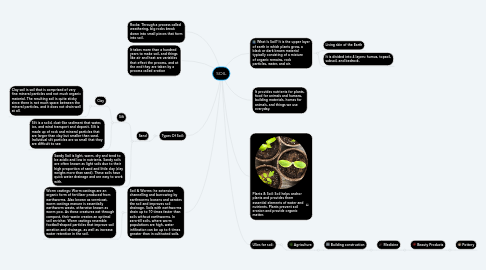
1. Rocks: Through a process called weathering, big rocks break down into small pieces that form into soil.
2. It takes more than a hundred years to make soil, and things like air and heat are variables that effect the process, and at the end they are taken by a process called erotion
3. Types Of Soil:
3.1. Sand
3.1.1. Silt
3.1.1.1. Clay
3.1.1.1.1. Clay soil is soil that is comprised of very fine mineral particles and not much organic material. The resulting soil is quite sticky since there is not much space between the mineral particles, and it does not drain well at all.
3.1.1.2. Silt is a solid, dust-like sediment that water, ice, and wind transport and deposit. Silt is made up of rock and mineral particles that are larger than clay but smaller than sand. Individual silt particles are so small that they are difficult to see
3.1.2. Sandy Soil is light, warm, dry and tend to be acidic and low in nutrients. Sandy soils are often known as light soils due to their high proportion of sand and little clay (clay weighs more than sand). These soils have quick water drainage and are easy to work with.
4. Soil & Worms: he extensive channelling and burrowing by earthworms loosens and aerates the soil and improves soil drainage. Soils with earthworms drain up to 10 times faster than soils without earthworms. In zero-till soils, where worm populations are high, water infiltration can be up to 6 times greater than in cultivated soils.
4.1. Worm castings: Worm castings are an organic form of fertilizer produced from earthworms. Also known as vermicast, worm castings manure is essentially earthworm waste, otherwise known as worm poo. As these creatures eat through compost, their waste creates an optimal soil enricher. Worm castings resemble football-shaped particles that improve soil aeration and drainage, as well as increase water retention in the soil.
5. What Is Soil? It is the upper layer of earth in which plants grow, a black or dark brown material typically consisting of a mixture of organic remains, rock particles, water, and air.
5.1. Living skin of the Earth
5.2. It is divided into 4 layers: humus, topsoil, subsoil, and bedrock.
6. It provides nutrients for plants, food for animals and humans, building materials, homes for animals, and things we use everyday.
7. Plants & Soil: Soil helps anchor plants and provides them essential elements of water and nutrients. Plants prevent soil erosion and provide organic matter.
8. USes for soil:
8.1. Agriculture
8.1.1. Building construction
8.1.1.1. Medicine
8.1.1.1.1. Beauty Products

